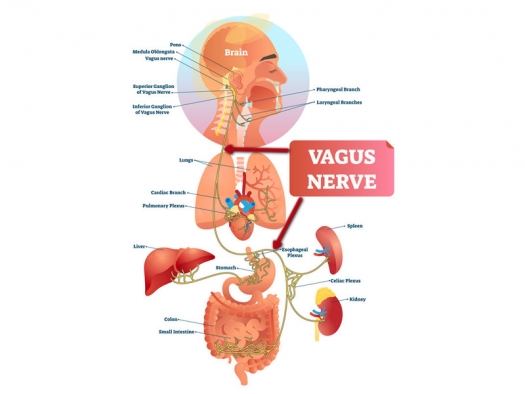VagusNerve.jpg

Illustration by normaals / 123rf.com
The vagus nerve is a large nerve that sends communication back and forth between the organs and the brain.
Is your brain causing your leaky gut? One of the ways brain dysfunction can contribute to leaky gut is through poor vagus nerve activity. The vagus nerve is a large nerve that sends communication back and forth between the organs and the brain. When the brain is in poor health it can inhibit vagal nerve activity, thus robbing the digestive tract of optimal function.
We have a few ways to spot poor vagal nerve function in an exam. For instance, since the vagus is responsible for bowel motility, a practitioner should be able to hear rumbling in the abdomen with a stethoscope. When the gut-brain axis is impaired, it is common to hear very little rumbling.
The vagus nerve is responsible for raising the uvula, the tissue in the back of your throat that looks like a punching bag. When you visit your doctor and say “ahh” he or she is looking for it to rise. When the vagus is not working well, the uvula does not rise much.
The gag reflex is also not very responsive. When exam findings show these functions are poor in a person with chronic digestive problems and a poor brain function, it indicates a strong possibility the gut-brain axis is not working well.
It is not uncommon for doctors to ignore the gut-brain axis in patients with chronic gut complaints. Interventions such as enzymes, probiotics, and other digestive aids may improve digestive health, but the clinical focus should also support brain health to improve the gut-brain axis.
Improving your vagus nerve
Like muscles, neurons need constant stimulation to be healthy. If you break your arm and wear a cast, the muscles shrink within a few weeks from reduced activity. Neurons are no different. Without activation they lose function. Remember, 90 percent of the brain’s output goes through the brainstem. If a poorly functioning brain does not stimulate the vagus nerve, the result is reduced activation of the gastrointestinal tract.
In functional medicine brain care, practitioners rehabilitate the vagus nerve through exercises that make it stronger. Brain pathways can be strengthened just like muscles.
For example, a person with weak biceps can make them stronger doing bicep curls, which develops proteins in the muscles to build strength. Functional neurology brain rehabilitation is no different. As you stimulate weak neurons they develop more proteins to become stronger. This is called the development of positive plasticity and can be done with any part of the brain. If you have a poorly functioning gut-brain axis and vagus nerve, neurological exercises can increase the plasticity and function of the vagus pathway.
Vagal exercises are easy to perform at home. I commonly prescribe the exercises below to my patients who have poor vagal tone and gut-brain axis failure.
Gargle
The first exercise is to gargle with water several times a day. The vagus nerve activates the muscles in the back of the throat that allow you to gargle. Gargling contracts these muscles, which activates the vagus nerve and stimulates the gastrointestinal tract.
Drink several large glasses of water per day and gargle each sip until you finish the glass of water. You should gargle long enough and deep enough to make it a bit challenging. A two-second light gargle may be equivalent to using a 2-pound dumbbell to strengthen your arm versus a 10-pound dumbbell. It will not work unless it is more challenging. Do this exercise for several weeks to help strengthen the vagal pathways.
Sing loudly
I also encourage my patients to sing as loudly as they can when they are in their car or at home. This works the muscles in the back of the throat to activate the vagus. This exercise may become a nuisance for family members, but I still recommend it.
Gag
I also have patients purchase a box of tongue blades so they can stimulate their gag reflex throughout the day. Do not jab the back of your throat with the tongue blade and hurt yourself, just lay the tongue blade on the back of your tongue and push down to activate a gag reflex.
Gag reflexes are like doing push-ups for the vagus while gargling and singing loudly are like doing sprints. It will take some time using these exercises to strengthen vagal tone and the gut-brain axis. You need to perform them for several weeks to produce change, just as you would with weight training. You cannot go to the gym for just a few days and expect your muscles to grow. Nor can you perform these exercises for a couple of days and expect to see profound change, although it does produce change very quickly for some.
Coffee enemas
In patients with brain degeneration who are having significant difficulty with regular bowel movements, I encourage them to perform daily coffee enemas. Distending the intestines with an enema activates the vagus. The caffeine in the coffee stimulates intestinal motility by acting on cholinergic receptors. This allows the patient to relieve bowel contents, which is very important for overall health.
Many people notice bowel function improves over time and they can begin weaning off the enemas. This is because the enemas help develop positive plastic change in their vagal system pathways. Unfortunately, some people have such rapid brain degeneration that it outpaces the ability to gain positive changes. In this case the coffee enema is used to prevent impacted bowels.
A coffee enema is very easy to do. For detailed instructions, see my article “How and why to do a coffee enema.”
The coffee will stimulate the cholinergic receptors in your intestines and activate motility as well as stimulate your vagal system to develop plasticity. The cholinergic stimulation from coffee will also cause your gallbladder to contract, helping release liver metabolism end-products into your bowel for elimination.
Conclusion
If you do not have significant constipation, leaky gut, or other GI issues, but your gut-brain axis is compromised, it is still a good idea to build vagal tone (along with gargling, singing loudly, or performing gag reflexes on yourself). Loss of vagal tone is almost always secondary to poor brain function. Strategies to improve overall brain function are absolutely critical when working on gut function.
For more information go to drknews.com.
Vagus Nerve Causing Gut Symptoms? 4 Vagus Exercises to Help Heal Your Gut was originally published on the Dr. K. News website, October 2, 2019. Used with permission.


